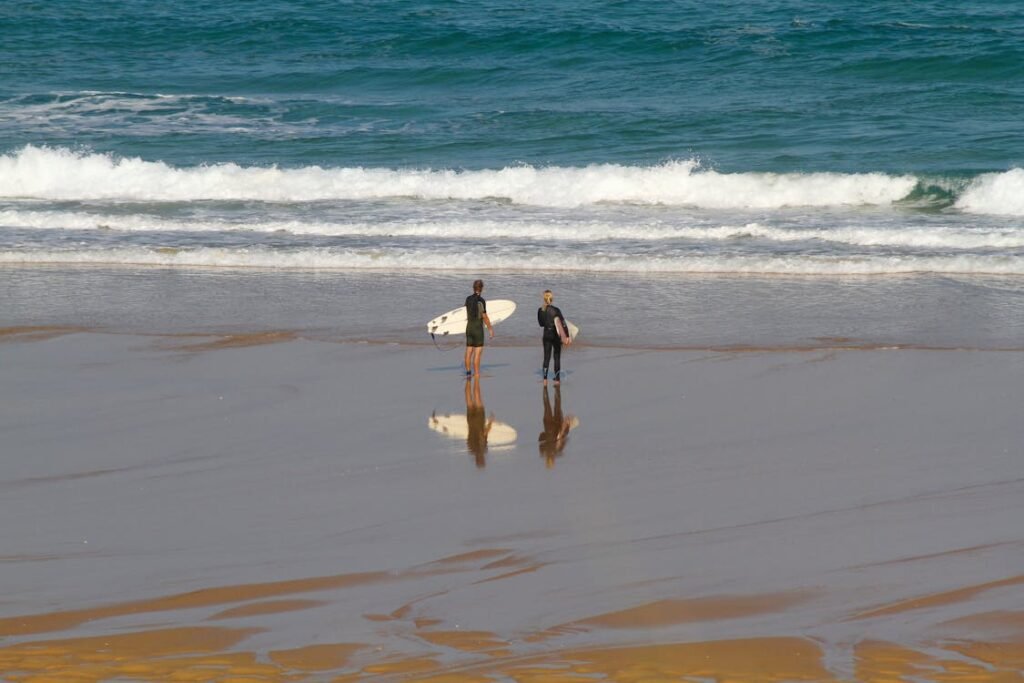Surfing is more than just a sport—it’s an experience of freedom, balance, and connection with the ocean. For those with limb loss, the idea of catching waves might once have seemed impossible. But today, advancements in prosthetic technology, adaptive surf programs, and inclusive training methods are making surfing more accessible than ever.
The ocean doesn’t discriminate. Whether you’re a beginner looking to ride your first wave or an experienced surfer returning to the sport after an amputation, the right prosthetic and proper training can help you regain confidence in the water. New designs allow for better movement, improved balance, and greater durability against saltwater and sand. Combined with growing support from the adaptive sports community, these innovations are breaking down barriers and opening up new possibilities for surfers of all levels.
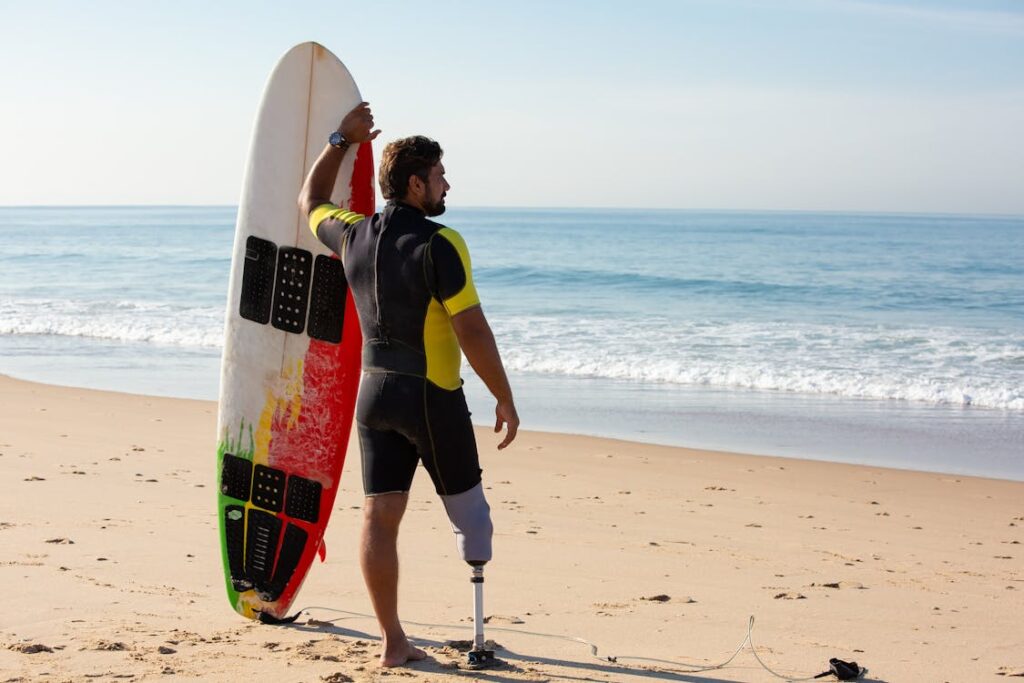
The Evolution of Prosthetic Technology for Surfing
In the past, surfing with a prosthetic was a challenge due to limitations in design and durability. Traditional prosthetics were built for walking and running, not for the unpredictable movements of the ocean.
Water exposure, sand buildup, and the constant shifting of weight on the board made it difficult for surfers with limb loss to maintain control and balance.
However, new innovations in prosthetic design have transformed what’s possible in the water. Today’s surfing prosthetics are made with high-performance materials that resist corrosion from saltwater while providing better flexibility and grip.
Customizable sockets, lightweight frames, and waterproof components make it easier for surfers to move naturally, whether they’re paddling out or carving through waves.
For lower-limb amputees, prosthetic feet designed specifically for surfing now feature flexible ankle joints that mimic the movement of a biological foot.
This allows for better shock absorption and responsiveness, helping surfers adjust their stance without losing stability. Some advanced models even include split-toe designs to improve board feel and control.
Upper-limb prosthetic users also benefit from specialized attachments that enhance paddling power and balance. Adaptive prosthetic arms can be designed with reinforced grips, allowing for stronger strokes when paddling through waves. Some models even offer detachable hands that allow for quick adjustments between paddling and standing on the board.
Why Fit and Comfort Matter in the Ocean
A prosthetic designed for surfing must feel secure yet comfortable. The ocean is unpredictable, and a poorly fitted prosthetic can cause instability, irritation, or even come loose in strong waves.
Proper socket fit is essential to prevent excessive movement, while lightweight materials ensure that the prosthetic doesn’t feel like an extra burden in the water.
Suspension systems are also a key factor. Vacuum suspension and adjustable locking mechanisms help keep the prosthetic in place, even under the pressure of ocean waves. Some surfers opt for additional padding or custom-molded sockets to ensure a snug, pain-free fit.
Adjustments are often necessary as a surfer progresses. Beginners may start with a more stable prosthetic designed for balance, while more advanced surfers may prefer a flexible model that allows for sharper turns and better board control.
The key is finding a fit that feels natural and supports movement rather than restricting it.
At Robobionics, we understand how important fit and function are for sports prosthetics. If you’re looking for a prosthetic designed for water activities, we can help you find the right solution. Contact us today to explore custom prosthetic options tailored to your surfing goals.
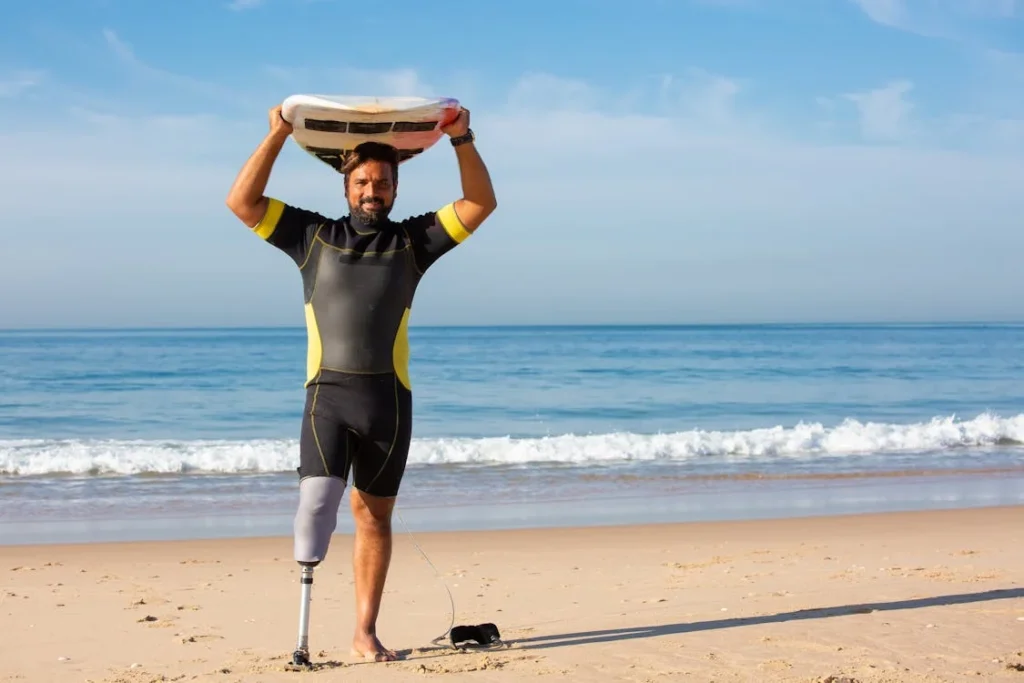
Learning to Surf with a Prosthetic: Techniques and Adaptation
Adapting to surfing with a prosthetic requires patience, practice, and an understanding of how your body moves on the board. While the fundamentals of surfing remain the same, certain techniques need to be adjusted based on the type of prosthetic used.
The key to success lies in finding the right balance between comfort, control, and fluid movement in the water.
Mastering Paddling and Wave Positioning
Paddling is the first skill every surfer must develop, and for those using a prosthetic, it requires some modifications.
Upper-limb prosthetic users need to focus on maintaining a strong, even stroke while paddling out to waves. If using a prosthetic arm, adjusting the paddle angle and grip strength can help reduce drag and improve efficiency.
Some adaptive surfers choose to paddle with one arm and use their residual limb for balance, which allows for better control while navigating through the water.
For lower-limb prosthetic users, positioning on the board is crucial. The prosthetic leg should be placed in a way that distributes weight evenly, preventing the board from tilting too much to one side.
Many adaptive surfers shift their body slightly forward to compensate for any stiffness in the prosthetic foot or knee. Keeping the core engaged helps maintain stability while paddling through waves.
The Pop-Up: Adjusting Your Stance and Technique
One of the most important moments in surfing is the pop-up—the transition from lying on the board to standing. This movement must be smooth and controlled, and for surfers using a prosthetic, it may require an alternative approach.
Lower-limb amputees often modify their pop-up technique to accommodate the mechanics of their prosthetic. Some use their arms and non-amputated leg to push up into a standing position before adjusting their prosthetic foot into place.
Others prefer a kneeling transition before shifting their weight into a full stance. Finding the right method depends on comfort, strength, and the flexibility of the prosthetic.
For upper-limb amputees, balance plays a critical role in the pop-up. Using a wider stance can help distribute weight evenly, reducing the risk of falling forward or losing control.
If the surfer has a prosthetic arm, adjusting the wrist or elbow position during the pop-up can improve leverage and make the transition smoother.
Finding Your Balance on the Board
Once standing, the focus shifts to maintaining balance and maneuvering through the waves. A prosthetic designed for surfing should provide enough flexibility to allow for minor adjustments in foot placement.
Some surfers use prosthetic feet with built-in shock absorption, which helps them stay steady on uneven wave surfaces.
A slight bend in the knees and an engaged core are essential for stability. Lower-limb prosthetic users often keep their weight centered over the board rather than leaning too far forward or backward.
If using a microprocessor knee, adjusting resistance settings based on wave conditions can improve responsiveness and control.
Upper-limb prosthetic users must focus on arm positioning to maintain equilibrium. Keeping the arms loose and ready to adjust helps counterbalance any shifts in the lower body.
Some adaptive surfers use rotational torso movements instead of arm-driven turns to maintain flow and control.
At Robobionics, we believe that the right prosthetic can make surfing feel more natural and intuitive. If you’re looking for a custom-fit solution to help improve your stability and mobility on the waves, reach out to us today.
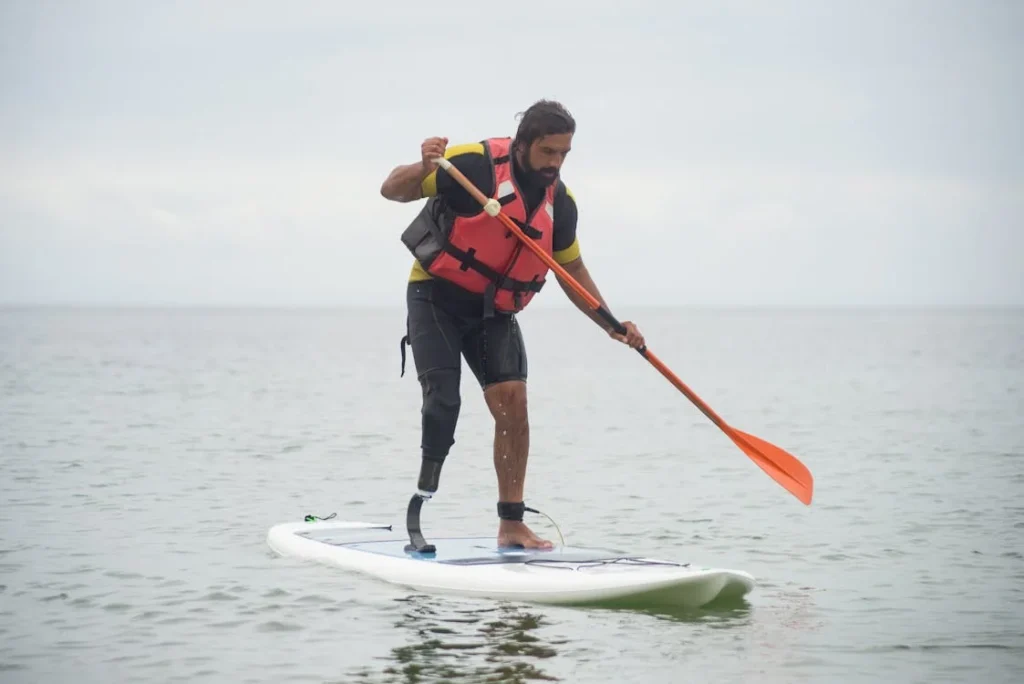
Overcoming Challenges and Building Confidence in the Water
Surfing with a prosthetic comes with unique challenges, but overcoming them is part of the journey. The ocean is unpredictable, and every wave is different, which means adaptation and persistence are key to building confidence.
Whether it’s adjusting to the weight of the prosthetic, dealing with balance shifts, or finding the right wave timing, each session in the water is an opportunity to improve.
Dealing with Wipeouts and Re-Entry
Falling is an inevitable part of surfing, especially while learning. For surfers using a prosthetic, wipeouts can sometimes feel more intense due to the added weight of the prosthetic or the way it interacts with the water.
The key is learning how to fall safely and get back on the board efficiently.
When falling, it’s best to stay relaxed and avoid stiffening up. If a prosthetic leg is causing drag underwater, some surfers choose to slightly lift it while resurfacing to reduce resistance.
Upper-limb prosthetic users should focus on keeping their arms loose to prevent unnecessary strain when hitting the water.
Getting back on the board after a fall is another important skill to master. Lower-limb amputees may find it easier to grip the board with their arms first before positioning their legs.
For those using a prosthetic arm, adjusting grip strength and paddle technique can help reorient the body faster. The goal is to develop a re-entry method that feels smooth and efficient so that a wipeout doesn’t disrupt the rhythm of the session.
Managing Fatigue and Stamina
Surfing requires endurance, and using a prosthetic can sometimes increase energy expenditure. This is especially true when paddling out through strong currents or maintaining balance over long periods.
To improve stamina, many adaptive surfers focus on cross-training activities such as swimming, core workouts, and flexibility exercises.
For lower-limb prosthetic users, strengthening the muscles around the hips, glutes, and core helps improve stability, reducing the strain on the residual limb. Practicing yoga or balance drills on land can also translate to better control on the board.
Upper-limb prosthetic users can benefit from shoulder and arm conditioning to enhance paddling strength. Resistance bands, lightweight dumbbells, and mobility exercises help build endurance, making each session in the water less exhausting.
Overcoming Mental Barriers
Confidence plays a huge role in surfing. Many new surfers—whether they use a prosthetic or not—experience self-doubt when starting out.
Fear of falling, hesitation in catching waves, or worrying about how others perceive them can hold surfers back from fully enjoying the experience.
The best way to overcome these mental barriers is to focus on progress rather than perfection. Every successful wave, no matter how small, is a step forward.
Training with supportive surf instructors, joining adaptive surf communities, and surrounding yourself with encouraging surfers can make a big difference in confidence.
Visualization techniques can also help. Many athletes use mental imagery to picture themselves successfully catching and riding waves. This practice helps build muscle memory and reinforces positive thinking, reducing anxiety when actually in the water.
Connecting with the Adaptive Surfing Community
One of the most empowering aspects of surfing with a prosthetic is becoming part of a growing community of adaptive surfers.
Across the world, surf schools, competitions, and training programs are dedicated to helping individuals with limb loss experience the joy of riding waves. These communities offer not just skill-building opportunities but also mentorship, encouragement, and shared experiences.
Adaptive surfing competitions are becoming more popular, giving athletes with prosthetics the chance to showcase their skills at local, national, and international levels.
Events like the ISA World Para Surfing Championship provide a platform for surfers of all abilities to compete and inspire others.
Being part of a community also means having access to valuable advice. Learning from experienced adaptive surfers who have gone through similar challenges can speed up the learning process.
Whether it’s tips on prosthetic adjustments, board modifications, or mental strategies, the insights gained from fellow surfers can be invaluable.
At Robobionics, we are passionate about making sports more accessible through advanced prosthetic technology. If you’re looking for expert guidance on choosing the best prosthetic for surfing, contact us today to take the next step toward conquering the waves.
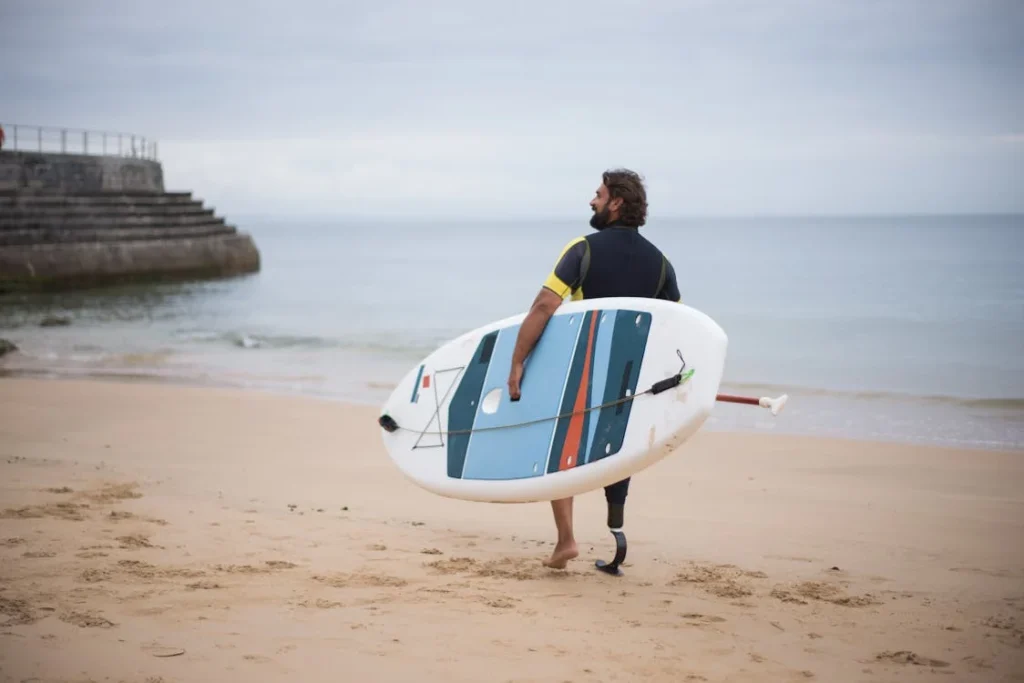
The Future of Adaptive Surfing: Innovations and Opportunities
Surfing with a prosthetic is no longer just a possibility—it’s becoming a mainstream reality.
Thanks to continuous advancements in prosthetic technology, adaptive sports programs, and the growing recognition of inclusive athletics, the future of surfing for amputees is brighter than ever.
With cutting-edge designs, improved accessibility, and increasing opportunities for participation, more individuals with limb loss are taking to the waves with confidence.
Advancements in Surf-Specific Prosthetics
The next generation of prosthetic technology is focused on improving flexibility, control, and comfort for adaptive surfers.
New developments in prosthetic feet, knee joints, and upper-limb attachments are making movements on the board feel more natural, reducing the learning curve for new surfers and enhancing performance for experienced riders.
One of the most exciting innovations is hydrodynamic prosthetics, which are specifically designed for water sports. These prosthetics are built with lightweight, corrosion-resistant materials that provide better resistance to saltwater and sand.
Some models incorporate adjustable flex ankles that allow surfers to shift weight smoothly, improving turns and stability on the board.
For upper-limb amputees, adaptive paddling prosthetics are evolving to offer better range of motion and grip strength.
Some prosthetic arms are now designed with interchangeable attachments, allowing surfers to switch between a paddle-specific grip and a more flexible hand structure for balancing and maneuvering.
These improvements are helping upper-limb amputees paddle more efficiently and maintain stability when catching waves.
Growing Accessibility and Surf Training Programs
As adaptive surfing gains recognition, more programs and organizations are making the sport accessible to individuals with limb loss.
Around the world, specialized surf schools, non-profits, and international competitions are offering opportunities for people to learn, train, and compete in an inclusive environment.
Many surf camps now provide customized training sessions for surfers with prosthetics, helping them refine their skills in a supportive setting.
These programs teach everything from paddling techniques and wave timing to advanced maneuvers, ensuring that surfers of all levels can progress at their own pace.
Competitions like the ISA World Para Surfing Championship and national adaptive surfing leagues are paving the way for elite athletes to showcase their talents on the world stage.
As these events continue to grow, they inspire more individuals to challenge themselves and push the boundaries of what’s possible in the sport.
Inclusivity in the Surfing Industry
The surfing industry is becoming more inclusive, with brands, surf schools, and professional organizations recognizing the importance of adaptive athletes.
Surfboard manufacturers are now designing boards that cater to the needs of adaptive surfers, incorporating features like wider decks for extra stability, modified traction pads, and customized fin setups for better control.
Additionally, mainstream surf events are increasingly including adaptive divisions, allowing athletes with prosthetics to compete alongside able-bodied surfers. This shift in mindset is helping break stereotypes and normalize the presence of adaptive athletes in extreme sports.
Breaking Barriers and Changing Perceptions
The future of adaptive surfing isn’t just about technology—it’s about changing how people view athletes with limb loss. As more surfers with prosthetics make headlines for their achievements, the perception of disability in sports is evolving.
These athletes are proving that with the right tools, training, and mindset, they can compete at the highest levels just like anyone else.
Surfing is no longer limited by physical differences; it’s about passion, determination, and the willingness to push through challenges.
With continued advancements in prosthetic design, growing access to surf programs, and increasing recognition in the sports world, the dream of riding waves is now a reality for more people than ever before.
At Robobionics, we are committed to supporting the future of adaptive sports through innovative prosthetic solutions. If you’re ready to explore high-performance prosthetics designed for water sports, get in touch with us today and take your surfing journey to the next level.
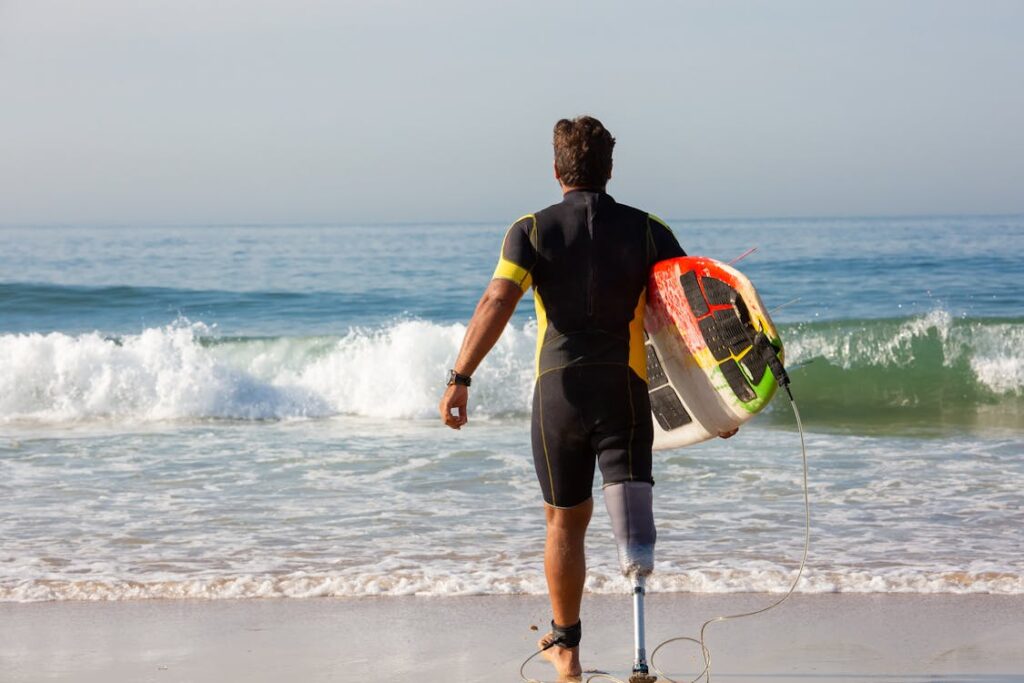
Customizing Your Prosthetic for Surfing: Finding the Perfect Fit
Every surfer has a unique style, and the same applies to those using prosthetics. A prosthetic that works well for one surfer might not be ideal for another.
Customization is key to ensuring that a prosthetic limb feels natural, performs efficiently, and provides the best experience in the water. From choosing the right materials to adjusting alignment and suspension, fine-tuning a prosthetic for surfing can make all the difference.
Choosing the Right Materials for Durability and Performance
Saltwater, sand, and constant movement put extra demands on a prosthetic, so choosing the right materials is essential. Traditional prosthetics, which are designed for walking or running, often struggle to withstand the ocean’s harsh conditions.
Surf-specific prosthetics, however, use corrosion-resistant materials such as titanium, carbon fiber, and marine-grade stainless steel to prevent rusting and deterioration over time.
Silicone liners and waterproof suspension systems help create a secure and comfortable fit, preventing unnecessary movement inside the socket.
Some surfers prefer gel-based liners for additional cushioning, which can help reduce pressure points when standing on the board for extended periods.
Adjusting Suspension and Fit for Maximum Stability
Suspension is what keeps the prosthetic securely attached to the limb, and it plays a critical role in surfing. Since water creates extra resistance and pressure on the prosthetic, a strong yet flexible suspension system is necessary to maintain control.
Many adaptive surfers prefer vacuum suspension systems, which create a tight seal between the socket and residual limb, reducing unwanted movement while maintaining comfort.
Some surfers opt for adjustable locking mechanisms that allow them to fine-tune how tight or loose their prosthetic feels depending on wave conditions.
A snug fit provides more stability for aggressive maneuvers, while a slightly looser fit can allow for greater range of motion during paddling and turns.
Customizing Foot and Knee Components for Better Mobility
For lower-limb amputees, prosthetic feet and knees need to match the movement demands of surfing. Flexible ankle joints allow for a more natural weight shift, helping surfers adjust to wave motion without feeling rigid.
Some prosthetic feet are designed with split-toe or curved features to improve grip on the board, allowing for better control when making sharp turns.
Above-knee amputees can benefit from microprocessor-controlled knees, which automatically adjust to different wave conditions and board positions.
These high-tech prosthetics can sense movement changes in real-time, providing better balance and shock absorption when riding over choppy waves.
Modifying Upper-Limb Prosthetics for Surfing Efficiency
For upper-limb prosthetic users, grip strength and mobility are the two most important factors. Some surfers prefer multi-grip hands that allow for a more secure hold when paddling, while others use quick-release wrist attachments to switch between different functions easily.
Lightweight, waterproof prosthetic arms with reinforced joints help withstand the impact of waves, making paddling and balancing easier.
Some surfers choose shorter prosthetic arms to reduce drag in the water, while others prefer adaptive paddles that provide extra propulsion when moving through strong currents.
The Importance of Regular Adjustments and Maintenance
A prosthetic that works perfectly on land may need adjustments for the dynamic environment of the ocean. Regularly checking the socket fit, suspension system, and joint flexibility ensures that the prosthetic continues to perform optimally.
After every surf session, rinsing the prosthetic with fresh water helps prevent salt buildup, while routine inspections for wear and tear keep it in top condition.
As surfers progress in skill level, their prosthetic needs may change. A beginner may prioritize stability and balance, while an advanced surfer might seek more flexibility for sharper turns.
Customizing a prosthetic over time helps align it with evolving techniques and comfort preferences.
At Robobionics, we specialize in customized prosthetic solutions for adaptive athletes. Whether you’re new to surfing or looking to upgrade your prosthetic for better performance, we can help you find the perfect fit.
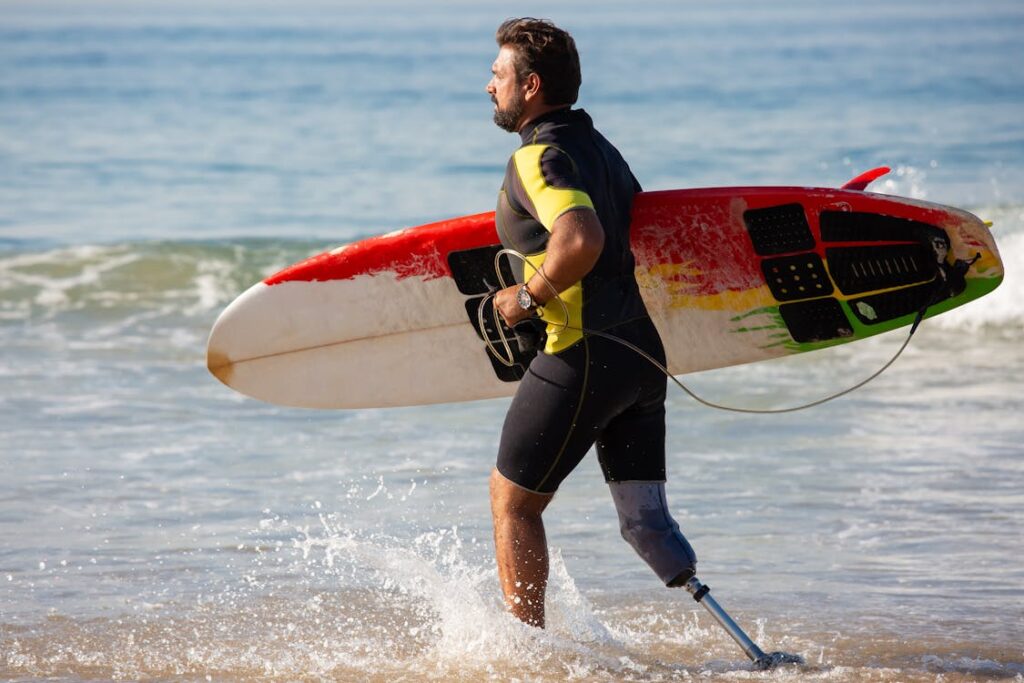
Surf Therapy: How Surfing with a Prosthetic Improves Mental and Physical Well-Being
Surfing is not just about the thrill of catching waves—it’s also a powerful way to heal both the body and mind. For many adaptive surfers, the ocean provides a unique form of therapy that goes beyond physical activity.
The rhythmic motion of the waves, the challenge of balancing on the board, and the sense of achievement that comes with each ride create a deeply rewarding experience.
Surf therapy has gained recognition worldwide as a method for helping individuals with limb loss regain confidence, rebuild strength, and reconnect with themselves.
Whether recovering from an amputation, adjusting to life with a prosthetic, or simply seeking a way to stay active, surfing offers both mental and physical benefits that enhance overall well-being.
Building Strength and Endurance
Surfing is an incredible full-body workout. Paddling strengthens the arms, shoulders, and core, while standing on the board engages the legs and stabilizing muscles.
For those using a prosthetic, surfing helps improve balance, flexibility, and coordination, making everyday movements smoother and more natural.
For lower-limb prosthetic users, riding waves increases hip and core stability, which improves posture and walking mechanics.
The constant adjustments required to stay upright on the board help develop proprioception, or the body’s awareness of movement and position, making transitions on land feel more fluid.
Upper-limb prosthetic users gain better arm strength and endurance through paddling, which improves cardiovascular fitness and overall mobility.
The effort required to push through waves and maintain grip on the board helps refine coordination, reducing strain on the rest of the body.
Enhancing Mental Resilience and Confidence
The ocean is unpredictable, just like life, and learning to surf teaches resilience. Falling off the board, missing waves, and facing strong currents all provide valuable lessons in patience, persistence, and adaptability.
For many individuals adjusting to life with a prosthetic, self-confidence can take time to rebuild. Surfing offers a sense of freedom and accomplishment that helps boost self-esteem.
The moment a surfer successfully rides a wave—even for just a few seconds—reinforces the idea that challenges can be overcome with practice and determination.
Studies have shown that time spent in the ocean has natural stress-reducing effects. The combination of fresh air, rhythmic waves, and physical movement triggers the release of endorphins, reducing anxiety and promoting a sense of calm.
Surf therapy programs have been used to help veterans, trauma survivors, and individuals with disabilities regain a positive outlook on life.
Fostering a Sense of Community and Inclusion
One of the most rewarding aspects of surfing is the community that comes with it. Adaptive surfers often find support, encouragement, and motivation from fellow surfers who share similar experiences.
Being part of a surf community helps build lasting friendships, providing a network of people who understand the unique challenges and triumphs of surfing with a prosthetic.
Many coastal regions now host adaptive surf programs, where trained instructors help individuals with prosthetics learn the basics of paddling, standing up, and riding waves.
These programs create a safe and welcoming environment where surfers of all skill levels can progress at their own pace.
Surf competitions, such as the ISA World Para Surfing Championship, showcase the incredible talent of adaptive surfers on an international stage.
These events not only provide a platform for competition but also raise awareness about the potential of athletes with prosthetics, inspiring others to pursue their own surfing goals.
Making Surf Therapy More Accessible
As more people recognize the benefits of surf therapy, organizations are working to make it more accessible to individuals with limb loss.
Many non-profits and surf schools offer free or low-cost sessions, ensuring that financial barriers do not prevent people from experiencing the healing power of the ocean.
Advancements in prosthetic technology designed for water sports are also helping more individuals participate. Waterproof prosthetics, improved suspension systems, and customized surfing limbs allow for a more natural and enjoyable experience in the waves.
At Robobionics, we believe in the power of adaptive sports to transform lives. Our mission is to provide high-quality prosthetics that enable individuals to pursue their passions without limitations.
If you’re interested in a surfing prosthetic that supports both physical performance and mental well-being, contact us today to find out how we can help you ride the waves with confidence.
Conclusion
Surfing with a prosthetic is more possible than ever, thanks to advancements in technology, adaptive training programs, and a growing community of inclusive athletes. Whether you’re a beginner looking to experience the ocean for the first time or an experienced surfer adapting to limb loss, the right prosthetic can help you regain confidence and freedom in the water.
Beyond the sport itself, surfing offers incredible physical and mental benefits. It strengthens the body, improves balance, and builds resilience. The ocean provides a unique form of therapy, helping individuals with prosthetics overcome challenges, push past self-doubt, and rediscover their potential.
With more organizations, competitions, and support networks dedicated to adaptive surfing, the future is bright for athletes with limb loss. As technology continues to improve, surfing will become even more accessible, empowering more people to ride waves without limits.
At Robobionics, we are committed to providing high-quality prosthetics designed for performance, comfort, and durability in extreme sports. If you’re ready to take the next step in your surfing journey, contact us today and discover how the right prosthetic can help you embrace the waves with confidence.



